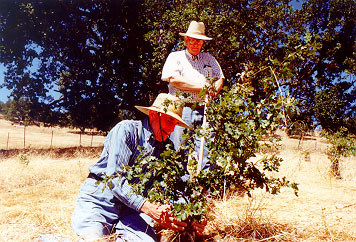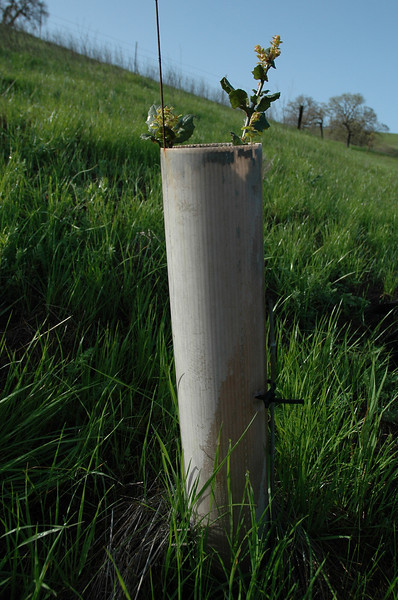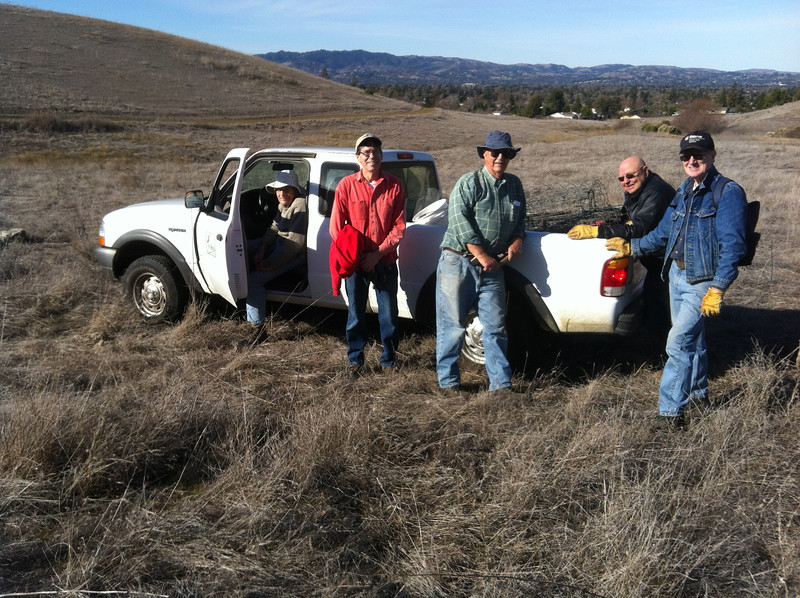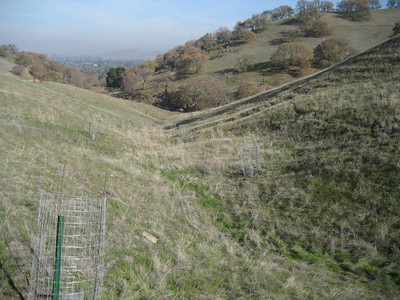Oak Habitat Restoration

Foundation Oak Restoration Porject founders Ralph Kraetsch and Richard Daniel
Project Background
The first plantings were done by several individuals 1989 -1990. Ron White, Senior Ranger, arranged for some experimental plantings in Shell Ridge above Bob Pond. In summer of 1991 a meeting was chaired by Dan Cather, new Supervising Ranger, to discuss with interested people the fact there were no little oak trees in the Open Space. Out of that meeting the Oak Habitat Restoration project began in 1991-92. The decision was made to concentrate our planting in the 1,425 acre Shell Ridge Open Space. In 1997 we began to plant in 967 acres at Lime Ridge Open Space.

We found that when planting in grazed areas we had to provide heavy duty fencing to protect the screen enclosures. To do this increased the time to plant and the overall cost by 80 percent. Unfortunately even with the additional protection the rate of survival was often disappointing. The suggestion was made to remove cattle from selected areas to evaluate the effects on the plants and seedlings. City Staff arranged to remove cattle from several hundred acres of Open Space. We have found with the removal of cattle we have begun to see the natural return of oak seedlings along with other plants and flowers.

Ralph Kraetsch, Stuart Mangini, Richard Daniel, Jerry Christopherson, Bill Barnard, and The "Oak Folks"
One of the principals in this endeavor is Ralph Kraetsch. You may have noticed the license on his car is Oak Folks. He has dedicated his time and worn out two 4 wheel drive pickups in over 20 years of Oak Tree Restoration.
Yearly Schedule of Activities
Starting in 2011 the decision was made to spend more time on the maintenance of the hundreds of trees that were planted over the past 20 plus years. Maintenance consists of opening up the protection around the planted trees and removing compost, leaves, grass, etc. Where appropriate we remove some or all of the protection devices.We have begun to notice trees we planted 15 to 20 years ago dying. In doing our maintenance work it looks like a little critter called a Vole, sometimes called Meadow Mice, are eating the bark and girdling the base of the trees. In many cases we have found the Voles have gotten inside the various protections, screens and plastic tubing. The Vole destruction is most notable in Marshall and Sutherland entrance areas of Shell Ridge. We have not observed this problem at South Lime Ridge.
At this time we are only doing Maintenance work. If you are interested in this activity or additional information contact Dick Daniel at oakhabitat@wcosf.org
Funding and Labor
Funding is provided by the sponsoring Walnut Creek Open Space Foundation and various direct gifts. The City of Walnut Creek provides storage space, some materials and much cooperation and support. All tools for maintenance work are provided by the Foundation and the City.Harvesting Acrons

Furture field of oaks. Notice the fences to protect the oak saplings from cows and other large herbivores




 Join
Join Donate
Donate Volunteer
Volunteer Maps
Maps Newsletter
Newsletter Facebook
Facebook
